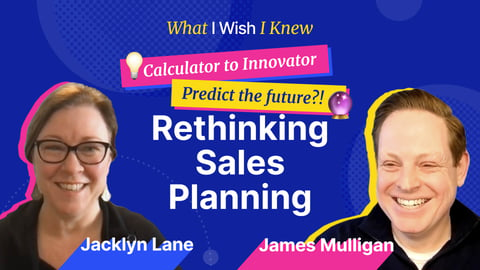For many sales managers and revenue leaders, planning for 2025 has already started. We're in an era where technology evolves daily, forcing sales leaders to adopt advanced tools and strategies to stay ahead. Meanwhile, shifting customer preferences and changing markets are diminishing executive confidence in go-to-market planning. In fact, the SBI Growth Advisory’s latest report revealed that only 52% of CEOs believe in growth plans.
Poor sales planning has become the single biggest threat to revenue growth. In 2025, growth-at-all-costs is no longer feasible. How can sales leaders stay profitable with limited resources?
We show you the common mistakes sales leaders must avoid for success, and provide actionable strategies to build executive confidence and navigate market challenges with connected, agile plans.
Understanding the Changing Sales Landscape
The sales environment and overall market coming into 2025 is very different from just a few years ago. The introduction of technological advancements such as AI are no longer optional but essential components of a successful sales strategy. Consumer behavior has also evolved, with customers expecting personalized experiences and quick, data-driven responses.
Growth has taken a backseat – as twice as many CEOs are now prioritizing value creation by strategically managing expenses, signaling a major shift towards profitability-focused initiatives. This shift has led many CEOs to evaluate their team’s go-to-market strategies, recognizing that an optimized go-to-market approach is crucial for aligning resources more effectively and driving profitable revenue growth.
Data analytics and real-time revenue data insights have become sales fundamentals, enabling sales reps to make informed decisions and adapt swiftly to changes. Ignoring these market shifts is a risk. It can also stall profits and lose confidence in your sales executives. Without these tools, sales teams risk missing key insights, stall decision-making, and weaken strategies. This threatens hitting profit goals and can cause C-Suite to lose confidence.
There is good news. CEOs and leaders who nail their go-to-market strategy are 2x more likely to meet or exceed their revenue expectations, with 74% achieving or surpassing their goals. By avoiding the following mistakes, sales and revenue leaders can position themselves to become more successful.
Common Mistakes Sales Leaders Can’t Afford to Make
1. Neglecting Continuous Development and Effective Coaching
Sales leaders who fail to invest in continuous training and development for their teams risk falling behind. Outdated skills and a lack of ongoing coaching can lead to underperformance. Going into 2025, it's crucial to have a robust plan for your sales teams’ growth, reinforcing essential skills, offering training courses, and fostering a culture of continuous learning. Equally important is investing in self-development as a leader to avoid burnout and maintain sharp decision-making.
2. Failing to Embrace Technology and Data-Driven Strategies
Resistance to AI, automation, and data-driven approaches is no longer an option. Sales executives must integrate advanced technologies into their strategies to stay competitive. Leveraging tools like an AI-powered incentive compensation management system and sales performance analytics is essential for making informed decisions and maintaining a competitive edge going forward.
3. Poor Communication and Lack of Team Alignment
Silos stall profits. Misalignment between sales organizations and revenue teams, coupled with ineffective communication, can lead to missed opportunities and inconsistent performance. As sales processes and onboarding become more complex, clear and consistent communication is key to ensuring all teams work towards common goals. Standardizing sales processes and aligning expectations from day one are critical for success.
4. Ignoring Strategic Leadership in Favor of Management Tasks
Overemphasizing day-to-day management tasks while neglecting long-term leadership activities can stifle growth and stall profits. In 2025, sales leaders need to strike a balance between tactical operations and strategic vision. Allocating time for strategic go-to-market planning and avoiding the trap of letting urgent tasks overshadow important ones will be vital for sustainable success.
5. Overlooking Customer-Centric Strategies
Failing to listen to and act on customer feedback, or setting unrealistic targets without customer insights, can derail sales efforts and result in poor planning. A customer-first approach is essential for the best sales success. Leaders must ensure that their strategies are grounded in real customer needs and that targets are achievable and data-driven to foster trust and long-term relationships.
6. Underestimating the Importance of Team Optimization
Spending too much time on low performers while neglecting top and middle achievers can be a costly mistake. Poor hiring and firing practices further exacerbate this issue. In 2025, sales leaders must focus on nurturing top talent and making strategic hiring decisions to build a high-performing team. Using data-driven insights to support these decisions will be essential.
7. Micromanaging and Undermining Team Autonomy
Taking over sales tasks or micromanaging the team can stifle growth and autonomy, leading to low morale and productivity. Empowering sales teams through delegation and reducing micromanagement will be key moving forward to creating fundamental sales skills, and building a confident and effective sales talent. Leaders should focus on coaching and guiding rather than controlling every aspect of the sales process.
Strategies to Avoid Sales Leadership Mistakes
Now that you know the mistakes to avoid, the question becomes: how can you avoid them? The simplest answer is adopting a proactive approach.
Here are 5 proactive strategies sales leaders can adopt:
- Invest in Regular Sales Training and Development: Foster a continuous learning culture with role-specific training modules.
- Leverage Technology and Data Analytics: Implement AI and machine learning tools to enhance decision-making and operational efficiency.
- Enhance Communication and Collaboration: Ensure regular team meetings and clear role definitions to break down silos.
- Prioritize Customer-Centric Approaches: Create feedback loops and personalized experiences for each customer interaction.
- Set Realistic and Achievable Targets: Use data-driven goal setting and conduct regular performance reviews.
Planning for Sales in 2025
When planning for 2025, sales managers and sales leaders have a unique opportunity to get ahead of the competition with the right go-to-market strategy. By avoiding detrimental mistakes and leveraging the right tools and strategies, they can meet revenue goals, build executive confidence and break down silos. The key is to stay proactive, embrace change, and continually invest in both their teams and themselves.
Want to learn more ways to enhance your go-to-market strategies, enhance sales performance and lead your team to success?
Grab a copy of the SBI CEO Value Creation Pulse, Summer 2024: Declining Confidence in the Target, the Plan, and the Go-to-Market Model for more insights.
Check out our handy checklist:
Checklist: Sales Planning for 2025
1. Conduct Regular Training Sessions:- Schedule ongoing training programs.
- Focus on both technical and soft skills development.
- Utilize AI-powered tools and analytics.
- Invest in automation for routine tasks.
- Regularly schedule cross-functional team meetings.
- Standardize communication protocols.
- Create channels for continuous customer feedback.
- Use insights to refine sales strategies.
- Regularly evaluate team performance.
- Focus on nurturing top and middle achievers.
- Delegate responsibilities effectively.
- Reduce micromanagement and empower your team.




